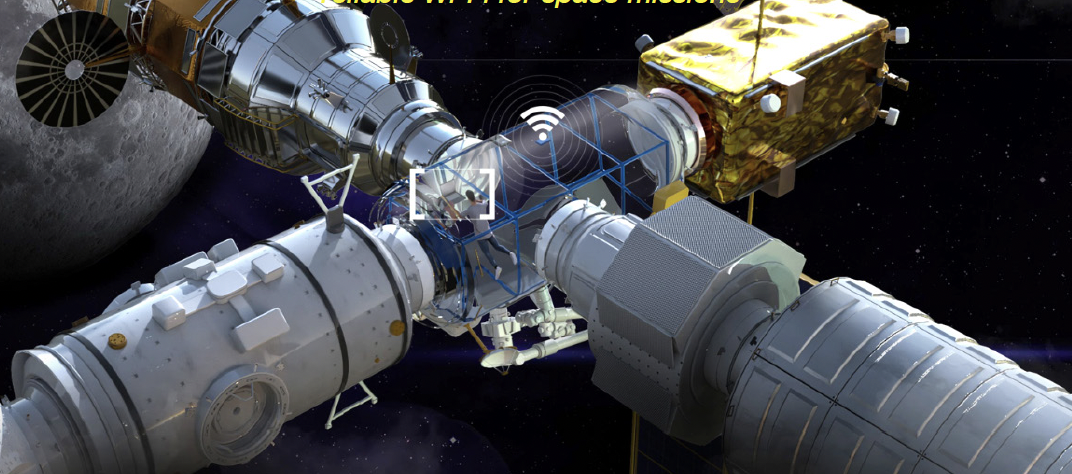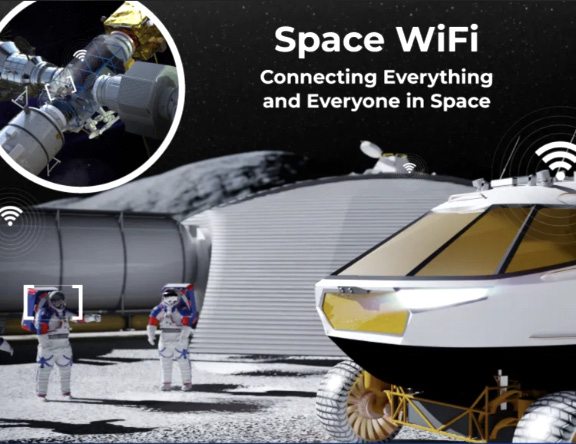As the commercialization of space advances and more spacecraft, people, and things are operating in Low Earth Orbit (LEO) and beyond, Wi-Fi in space is becoming crucial to support momentous space missions.

While Wi-Fi has been demonstrated aboard the International Space Station by NASA using one-off, non-radiation-tolerant units, today there isn’t a commercially available, space-grade Wi-Fi solution.
The usefulness of Wi-Fi in space has been proven via improvised solutions with limited capability and applicability.
At Solstar, we are developing full Wi-Fi capabilities and features designed to support any Wi-Fi-enabled device or application.
As the requirements for Wi-Fi connected capabilities continue to evolve and increase in LEO, cislunar, and lunar surface applications, reliable, secure Wi-Fi solutions will be essential to fulfilling mission objectives.
The State of Wi-Fi in Space Today
Up until 2008, even the International Space Station (ISS) didn’t have Wi-Fi on board. Since 2008, Wi-Fi capabilities have continued to improve.
However, the hardware used is not purpose-built and it is not radiation hardened or even tolerant. Beyond the ISS, Wi-Fi has not become generally available aboard other spacecraft.
In 2018, Solstar provided the first commercial WiFi connection aboard Blue Origin’s New Shepard rocket. Solstar has proven the viability of existing commercial constellations as the supporting communications infrastructure on three previous suborbital space flights in collaboration with NASA’s Flight Opportunities Program (FOP). The Solstar Schmitt satellite user terminal was the first commercial Wi-Fi Access Point in space operated by a private company.
Solstar developed and flew the Schmitt terminal on Blue Origin’s New Shepard crew capsule twice in 2018. This proof-of-concept demonstrated the first commercial Wi-Fi hotspot and bidirectional internet connection to a spacecraft using a commercial satellite network.
This innovative hardware will be displayed as part of the Smithsonian National Air & Space Museum’s “Living in the Space Age” exhibition beginning in 2025.
Solstar Space’s Schmitt Space Communicator has been accessioned into the Smithsonian’s National Air and Space Museum’s collection. Dr. Martin Collins, curator of the museum’s civilian application satellites collection, presented Solstar Space Company CEO M. Brian Barnett the official deed of gift accepting the donation.

Solstar Space’s Schmitt Space Communicator has been
accessioned into the Smithsonian’s National Air and Space
Museum’s collection. Dr. Martin Collins, curator of the
museum’s civilian application satellites collection, presented
Solstar Space Company CEO M. Brian Barnett the official
deed of gift accepting the donation.
In 2018, Solstar sent the first commercial tweet from space. Imagine the first commercial phone call during a commercial flight, real time health data sent from above the Kármán line, and the first instant results from payloads on-board a commercial spacecraft. These are just a few of the use cases that will be supported by Space Wi-Fi.
Existing solutions focus primarily on connecting satellites to ground stations to support communications, navigation, and military operations on Earth. This technical approach has been in use since the 1950s, and communications points are limited to ground station flyovers. Immediacy of data and situational awareness necessitate better solutions with real time data and images. Today, the connections for people and things aboard spacecraft are surprisingly limited.
What Does it Take to Have Reliable and Secure Space Wi-Fi?
There are six main missing pieces for reliable Space Wi-Fi:
-
Commercially available robust, radiation-hardened, space-grade, purpose-built Wi-Fi equipment
Narrowband and wideband communication relays to provide immediate access to Wi-Fi data from and for spacecraft, people, and things in space
A network ecosystem to support the necessary connections between spacecraft, people, and things operating in space
Services to provide the real time, reliable connectivity
Software to commission, monitor, and manage the space network environment
Spacecraft must be launched with the necessary technology onboard
Space Wi-Fi and on-orbit SATCOM isn’t broadly available today because it is difficult and expensive to deploy. Several companies have tried to launch solutions, both RF and optical, but none of them undertook the millions or even billions in investment required.
This has led to failures. By taking a different approach and partnering with and leveraging existing commercial satellite networks, Solstar is eliminating a significant portion of the development time and costs associated with making Space Wi-Fi broadly available.
Comprehensive Connectivity Via Space Wi-Fi Future Space missions will depend on widespread, reliable Wi-Fi across various space environments. Today there are gaps in coverage for LEO, cislunar, and lunar surface applications, however these gaps can be filled. The uses for Space Wi-Fi are as broad and varied as they are for Wi-Fi on Earth.
Applications and Mission Support
Solstar’s space-rated Wi-Fi Access Points and client Wi-Fi Network Cards are being engineered to support Rendezvous, Proximity Operations, and Docking (RPOD) to enable In-Space Servicing, Assembly, and Manufacturing (ISAM), scientific and medical experiment data, and other applications.

Solstar Wi-Fi access points and client cards will be used on a broad range of space missions including LEO satellites, space stations, and service spacecraft, lunar gateways, transfer vehicles, landers, and modules, and lunar surface habitats, vehicles, spacesuits, and IoT mesh networks and wireless bridges. The need for space Wi-Fi is virtually unlimited and growing.
Space Wi-Fi Requirements:
• Radiation-hardened and temperature-tolerant
• Engineered to withstand space launches
• High-Power Radio Frequency (RF) and/or optical
• Elimination of cable runs aboard spacecraft
• Wireless solutions reduce complexity and increase reliability
• Future-proof designs with OTA capabilities for updates and upgrades
• Ensuring longevity and adaptability of technology for future missions
• Compatibility and software support
• Support for IEEE 802.11 standards
• API-based remote management and updates for flexibility and efficiency
• Software-enabled hardware and services
Future Uses and Expansion

Space Wi-Fi is not only required in LEO for space stations, satellites, and service spacecraft, but it will also be critical for cislunar missions, lunar orbit, and on the surface of the Moon.
Everything from lunar gateways, transfer vehicles and landers to surface habitats, modules, and even spacesuits will require a Wi-Fi link. In fact, these things in space will form IoT mesh networks and support a much broader range of missions.
We are at the cusp of a major network transformation and significant advancements that will make ubiquitous space Wi-Fi a reality. Although space Wi-Fi is currently very limited, there is a constantly expanding host of use cases that will intensify demand for solutions. The technologies, services, and software must be ready to support these and future requirements.
The innovations companies such as Solstar are currently developing will extend the space age network evolution and will play an integral role in the continued growth of the commercial space industry. The crew at Solstar and I are excited to bring Wi-Fi into space.
www.solstarspace.com

M. Brian Barnett
Author M. Brian Barnett is a serial entrepreneur with 36 years’ experience in civil and commercial space and the mobile satellite services industry. He began his career at NASA where he provided payload development and integration on the Space Shuttle, and he trained as an Astronaut Crew Interface Coordinator. After NASA, he wats hired by KPMG to help lead and grow their Commercial Space management consultancy. Solstar is his third commercial satellite services start-up.
Solstar Space is a leading commercial, space-based, connectivity company pioneering the use of Space Wi-Fi for all types of on orbit assets including satellites, space stations, launch vehicles, and more. Secure internet connection between spacecraft and Earth-based payload managers and satellite operators are offered and enable communications for crewed missions in sub-orbit, LEO, cis-lunar, and lunar surface operations. The company’s fast, reliable services, space-tested routers, Wi-Fi access points and hotspots, and space-based satellite data relays are being developed to deliver on-orbit connectivity and are supported by 24/7 customer care. These devices are installed on satellites and spacecraft prior to launch to keep crew, spacecraft, and Earth-based satellite operations teams connected.


